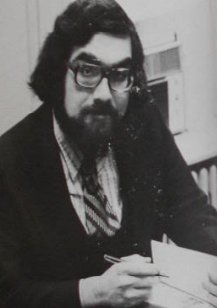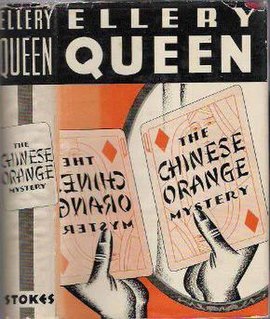Joseph Commings (New York, 1913 - Maryland, 1992) was an American writer of locked room mysteries. He wrote a series of soft-core sex novels, but is best known for his locked-room mystery/impossible crime short stories featuring Senator Brooks U. Banner." [1]
Commings began writing in 1947, and was first published in 10-Story Detective magazine in March, 1947. After three stories, Commings also began writing for Ten Detective Aces. For some reason, the editors of both magazines thought it would be a good idea to have a different detective. Commings merely changed the name of Banner to Mayor Thomas Landin, but kept everything else the same. All stories that were first printed in Ten Detective Aces and that have since been reprinted have changed the name of Landin back to Banner." [1]
By the 1950s, Commings submitted stories to Ellery Queen's Mystery Magazine , but Frederic Dannay (half of the writing/editorial team known as Ellery Queen) didn't like the character of Banner, so Commings was never printed in EQMM. It wouldn't be until 1957 that Commings would be able to print another Banner story." [1]
In 1957, Commings published stories in an offbeat mystery magazine, Mystery Digest. It was during this time that Commings would write his best-known story, The X Street Murders. Commings would continue to be published in Mystery Digest until it went bankrupt, his last story being The Giant's Sword in 1963." [1]
Commings would publish a few stories in The Saint Mystery Magazine until 1968. Commings would also publish a series of part crime/part sex novels. Commings attempted to write normal mystery novels, and locked room mystery novels, none of which was published. It wouldn't be until 1979, in Mike Shayne Mystery Magazine , that Commings would publish another Banner story, cowritten by Edward D. Hoch. (Commings was a friend of both John Dickson Carr and Edward D. Hoch.) Commings would continue to publish in MSMM until 1984; he died in 1992. The last Banner story, The Whispering Gallery, was not published until 2004, in the collection Banner Deadlines, published by Crippen & Landru." [1]
1. Murder Under Glass
3. The Spectre on The Lake
4. The Black Friar Murders
5. The Scarecrow Murders
6. Death By Black Magic
7. Ghost in the Gallery
8. The Invisible Clue
9. Serenade to a Killer
10. The Female Animal
11. The Bewitched Terrace
12. Through the Looking Glass
13. Three Chamberpots
14. Murderer's Progress
15. A Lady of Quality
16. Castanets, Canaries, and Murder
18. Open to Danger
19. Hangman's House
20. Betrayal in the Night
22. The Last Samurai
23. The Cuban Blonde
24. The Glass Gravestone
25. The Moving Finger
26. Stairway to Nowhere (with Edward D. Hoch)
27. Nobody Loves a Fatman
28. Assassination-Middle East
29. Dressed to Kill
30. Murder of a Mermaid
31. The Fire Dragon Caper
32. The Grand Guignol Caper (also known as The Vampire in the Iron Mask)
33. The Whispering Gallery (first published in Banner Deadlines)
Ellery Queen is a pseudonym created in 1929 by American crime fiction writers Frederic Dannay and Manfred Bennington Lee and the name of their main fictional character, a mystery writer in New York City who helps his police inspector father solve baffling murders. Dannay and Lee wrote most of the more than thirty novels and several short story collections in which Ellery Queen appeared as a character, and their books were among the most popular of American mysteries published between 1929 and 1971. In addition to the fiction featuring their eponymous brilliant amateur detective, the two men acted as editors: as Ellery Queen they edited more than thirty anthologies of crime fiction and true crime, and Dannay founded and for many decades edited Ellery Queen's Mystery Magazine, which has been published continuously from 1941 to the present. From 1961, Dannay and Lee also commissioned other authors to write crime thrillers using the Ellery Queen nom de plume, but not featuring Ellery Queen as a character; several juvenile novels were credited to Ellery Queen, Jr. Finally, the prolific duo wrote four mysteries under the pseudonym Barnaby Ross.
John Dickson Carr was an American author of detective stories, who also published using the pseudonyms Carter Dickson, Carr Dickson, and Roger Fairbairn.
The "locked-room" or "impossible crime" mystery is a type of crime seen in crime and detective fiction. The crime in question, typically murder, is committed in circumstances under which it was seemingly impossible for the perpetrator to commit the crime or evade detection in the course of getting in and out of the crime scene. The crime in question typically involves a crime scene with no indication as to how the intruder could have entered or left; for example, a victim found deceased in a windowless room that is sealed from the inside at the time of discovery. Following other conventions of classic detective fiction, the reader is normally presented with the puzzle and all of the clues, and is encouraged to solve the mystery before the solution is revealed in a dramatic climax.

Mystery is a fiction genre where the nature of an event, usually a murder or other crime, remains mysterious until the end of the story. Often within a closed circle of suspects, each suspect is usually provided with a credible motive and a reasonable opportunity for committing the crime. The central character is often a detective, who eventually solves the mystery by logical deduction from facts presented to the reader. Some mystery books are non-fiction. Mystery fiction can be detective stories in which the emphasis is on the puzzle or suspense element and its logical solution such as a whodunit. Mystery fiction can be contrasted with hardboiled detective stories, which focus on action and gritty realism.

William Anthony Parker White known by his pen-name Anthony Boucher, was an American author, critic, and editor, who wrote several classic mystery novels, short stories, science fiction, and radio dramas. Between 1942 and 1947 he acted as reviewer of mostly mystery fiction for the San Francisco Chronicle. In addition to "Anthony Boucher", White also employed the pseudonym "H. H. Holmes", which was the pseudonym of a late-19th-century American serial killer; Boucher would also write light verse and sign it "Herman W. Mudgett".
Clayton Rawson was an American mystery writer, editor, and amateur magician. His four novels frequently invoke his great knowledge of stage magic and feature as their fictional detective The Great Merlini, a professional magician who runs a shop selling magic supplies. He also wrote four short stories in 1940 about a stage magician named Don Diavolo, who appears as a minor character in one of the novels featuring The Great Merlini. "Don Diavolo is a magician who perfects his tricks in a Greenwich Village basement where he is frequently visited by the harried Inspector Church of Homicide, either to arrest the Don for an impossible crime or to ask him to solve it."

Ellery Queen's Mystery Magazine is a bi-monthly American digest size fiction magazine specializing in crime fiction, particularly detective fiction, and mystery fiction. Launched in fall 1941 by Mercury Press, EQMM is named after the fictitious author Ellery Queen, who wrote novels and short stories about a fictional detective named Ellery Queen. From 1993, EQMM changed its cover title to be Ellery Queen Mystery Magazine, but the table of contents still retains the full name.
Edward Dentinger Hoch was an American writer of detective fiction. Although he wrote several novels, he was primarily known for his vast output of over 950 short stories.

Christianna Brand was a British crime writer and children's author born in British Malaya.
William Theodore Link was an American film and television screenwriter and producer who often worked in collaboration with Richard Levinson.
Patrick Quentin, Q. Patrick and Jonathan Stagge were pen names under which Hugh Callingham Wheeler, Richard Wilson Webb, Martha Mott Kelley and Mary Louise White Aswell wrote detective fiction. In some foreign countries their books have been published under the variant Quentin Patrick. Most of the stories were written by Webb and Wheeler in collaboration, or by Wheeler alone. Their most famous creation is the amateur sleuth Peter Duluth. In 1963, the story collection The Ordeal of Mrs. Snow was given a Special Edgar Award by the Mystery Writers of America.
Phyllis Eleanor Bentley was an English novelist.

William Louis DeAndrea was an American mystery writer and columnist.
"The Problem of the Covered Bridge" (1974) is a mystery short story by Edward D. Hoch which was first published in Ellery Queen's Mystery Magazine. It is part of a sub-type of the locked room mystery known as an impossible crime story. It introduces the characters of Dr. Sam Hawthorn, Sheriff Lens, and the town of Northmont. It is included in Hoch's book Diagnosis: Impossible: The Problems of Dr. Sam Hawthorne. It is also included in All but Impossible!, the famous anthology edited by Hoch.

The Roman Hat Mystery is a novel that was written in 1929 by Ellery Queen. It is the first of the Ellery Queen mysteries.

The Chinese Orange Mystery is a novel that was written in 1934 by Ellery Queen. It is the eighth of the Ellery Queen mysteries.
James Powell is a Canadian author of mystery and humorous short stories. Many of his 130 stories have been published in Ellery Queen's Mystery Magazine. He has been nominated twice for the Crime Writers of Canada Award for the Best Short Story and, in 1989, won the Ellery Queen Readers' Award for the story "A Dirge for Clowntown" featuring Inspector Bozo of the Clowntown Police. Powell's occasionally dark sense of humor and developed irony has led to him being noted by Marvin Lachman as "The S.J. Perelman of the mystery story...outrageous, hilarious satires, international crime and surprise endings."
Douglas G. Greene is an American historian, editor, and author. He is the son of Margaret Chindahl Greene and the Reverend George L. Greene, He is married to Sandi Greene with whom he has a son, Eric and a daughter, Katherine, and has an identical twin, David L. Greene, and a younger brother Paul.
Crippen & Landru Publishers is a small publisher of mystery fiction collections, based in Cincinnati, Ohio, United States. It was founded in 1994 by husband and wife Sandi and Douglas G. Greene in Norfolk, Virginia, United States, and is named after murderers Dr. H. H. Crippen and Henri Landru. The Greenes's son Eric designed the logo. Jeffrey Marks succeeded Douglas G. Greene as publisher on January 1, 2018, while Dr. Greene remains active as Series Editor.

The Name Is Archer is a collection of short stories written by Ross Macdonald and featuring his detective hero, Lew Archer. Originally compiled in 1955 and published under the name John Ross Macdonald, more stories were added in later collections under different titles.